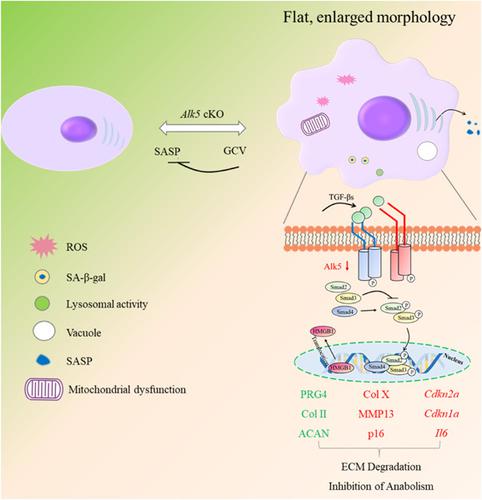当前位置:
X-MOL 学术
›
J. Cell. Physiol.
›
论文详情
Our official English website, www.x-mol.net, welcomes your feedback! (Note: you will need to create a separate account there.)
TGF‐β/Alk5 signaling prevents osteoarthritis initiation via regulating the senescence of articular cartilage stem cells
Journal of Cellular Physiology ( IF 5.6 ) Pub Date : 2021-01-16 , DOI: 10.1002/jcp.30231 Qiaoyan Tan 1 , Quan Wang 1, 2 , Liang Kuang 1 , Jinfan Zhang 1 , Xiuqin Peng 1 , Sen Liang 1 , Mi Liu 1 , Hangang Chen 1 , Shuai Chen 1 , Xiaoqing Luo 1 , Huabing Qi 1 , Can Li 1 , Fengtao Luo 1 , Shuo Huang 1 , Zhenhong Ni 1 , Min Jin 1 , Nan Su 1 , Jing Yang 1 , Peng Yang 1 , Bo Chen 1 , Liang Chen 1 , Xiaolan Du 1 , Yangli Xie 1 , Lin Chen 1
Journal of Cellular Physiology ( IF 5.6 ) Pub Date : 2021-01-16 , DOI: 10.1002/jcp.30231 Qiaoyan Tan 1 , Quan Wang 1, 2 , Liang Kuang 1 , Jinfan Zhang 1 , Xiuqin Peng 1 , Sen Liang 1 , Mi Liu 1 , Hangang Chen 1 , Shuai Chen 1 , Xiaoqing Luo 1 , Huabing Qi 1 , Can Li 1 , Fengtao Luo 1 , Shuo Huang 1 , Zhenhong Ni 1 , Min Jin 1 , Nan Su 1 , Jing Yang 1 , Peng Yang 1 , Bo Chen 1 , Liang Chen 1 , Xiaolan Du 1 , Yangli Xie 1 , Lin Chen 1
Affiliation

|
Osteoarthritis (OA) is the most common joint disease. The surface of joint cartilage is a defensive and first affected structure of articular cartilage (AC) during the pathogenesis of OA. Alk5 signaling is critical for maintaining AC homeostasis, however, the role and underlying mechanism for the involvement of Alk5 signaling in the phenotypes of articular cartilage stem cells (ACSCs) at the surface of AC is still unclear. The role of Alk5 in OA development was explored using an ACSCs‐specific Alk5‐deficient (cKO) mouse model. Alterations in cartilage structure were evaluated histologically. Senescence was detected by SA‐β‐gal, while reactive oxygen species (ROS), MitoTracker, and LysoTracker staining were used to detect changes related to senescence. In addition, mice were injected intra‐articularly with ganciclovir to limit the detrimental roles of senescent cells (SnCs). Alk5 cKO mice showed a decreased number of the slow‐cell cycle cells and less lubricant secretion at the surface accompanied with drastically accelerated cartilage degeneration under ageing and surgically induced OA conditions. Further studies showed that Alk5 deficient ACSCs exhibited senescence‐like manifestations including decreased proliferation and differentiation, more SA‐β‐gal‐positive cells and ROS production, as well as significantly swollen mitochondria and lysosome breakdown. We further found that local limitation of the detrimental roles of SnCs can attenuate the development of posttraumatic OA. Taken together, our findings suggest that Alk5 signaling acts as an important regulator of the SnCs in the superficial layer during AC maintenance and OA initiation.
中文翻译:

TGF-β/Alk5 信号传导通过调节关节软骨干细胞的衰老来预防骨关节炎的发生
骨关节炎(OA)是最常见的关节疾病。关节软骨表面是 OA 发病过程中关节软骨 (AC) 的防御性和首先受影响的结构。Alk5 信号传导对于维持 AC 稳态至关重要,然而,Alk5 信号传导在 AC 表面关节软骨干细胞 (ACSC) 表型中的作用和潜在机制尚不清楚。使用 ACSC 特异性Alk5探索了Alk5在 OA 发展中的作用-缺陷(cKO)小鼠模型。组织学评估软骨结构的改变。SA-β-gal 检测衰老,而活性氧 (ROS)、MitoTracker 和 LysoTracker 染色用于检测与衰老相关的变化。此外,小鼠关节内注射更昔洛韦以限制衰老细胞(SnCs)的有害作用。Alk5 cKO 小鼠在衰老和手术诱导的 OA 条件下显示出慢细胞周期细胞数量减少和表面润滑剂分泌减少,伴随着显着加速的软骨退化。进一步的研究表明,Alk5缺乏的ACSCs表现出衰老样表现,包括增殖和分化减少、SA-β-gal阳性细胞增多和ROS产生,以及线粒体显着肿胀和溶酶体分解。我们进一步发现,SnCs 有害作用的局部限制可以减弱创伤后 OA 的发展。综上所述,我们的研究结果表明,在 AC 维持和 OA 启动期间,Alk5 信号是表层 SnCs 的重要调节器。
更新日期:2021-01-16
中文翻译:

TGF-β/Alk5 信号传导通过调节关节软骨干细胞的衰老来预防骨关节炎的发生
骨关节炎(OA)是最常见的关节疾病。关节软骨表面是 OA 发病过程中关节软骨 (AC) 的防御性和首先受影响的结构。Alk5 信号传导对于维持 AC 稳态至关重要,然而,Alk5 信号传导在 AC 表面关节软骨干细胞 (ACSC) 表型中的作用和潜在机制尚不清楚。使用 ACSC 特异性Alk5探索了Alk5在 OA 发展中的作用-缺陷(cKO)小鼠模型。组织学评估软骨结构的改变。SA-β-gal 检测衰老,而活性氧 (ROS)、MitoTracker 和 LysoTracker 染色用于检测与衰老相关的变化。此外,小鼠关节内注射更昔洛韦以限制衰老细胞(SnCs)的有害作用。Alk5 cKO 小鼠在衰老和手术诱导的 OA 条件下显示出慢细胞周期细胞数量减少和表面润滑剂分泌减少,伴随着显着加速的软骨退化。进一步的研究表明,Alk5缺乏的ACSCs表现出衰老样表现,包括增殖和分化减少、SA-β-gal阳性细胞增多和ROS产生,以及线粒体显着肿胀和溶酶体分解。我们进一步发现,SnCs 有害作用的局部限制可以减弱创伤后 OA 的发展。综上所述,我们的研究结果表明,在 AC 维持和 OA 启动期间,Alk5 信号是表层 SnCs 的重要调节器。


























 京公网安备 11010802027423号
京公网安备 11010802027423号